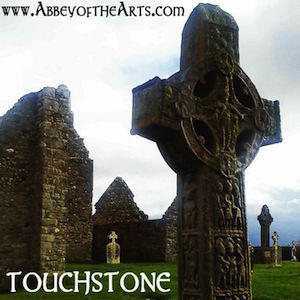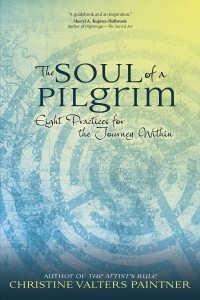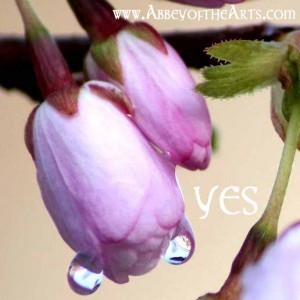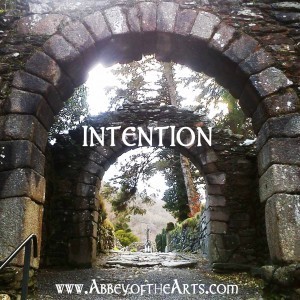Christine Valters Paintner's Blog, page 135
April 10, 2015
April 10: Touchstone – Pilgrimage of Resurrection(A Creative Journey through the Easter Season)
Word for today: Touchstone We need practices to act as touchstones so they can sustain us during the journey. They help remind us that the journey will take us beyond our narrow visions and connect with the sacred ground of being. We open our hearts and minds to a more intimate connection to the One who created us and in the process we start to discover our created purpose.
We need practices to act as touchstones so they can sustain us during the journey. They help remind us that the journey will take us beyond our narrow visions and connect with the sacred ground of being. We open our hearts and minds to a more intimate connection to the One who created us and in the process we start to discover our created purpose.
—Christine Valters Paintner, The Soul of a Pilgrim: Eight Practices for the Journey Within
Reflective Question: What intentional practices, (e.g. art-making, meditation, chanting, yoga,) could you commit to in order to help cultivate peace in your soul, and help anchor you when the seas of life grow stormy?
Next steps:
 Let the word, quote, and question inspire your creative practice today. (Download the list of daily words here.) Use the hashtag #soulofapilgrim when sharing on social media.
Let the word, quote, and question inspire your creative practice today. (Download the list of daily words here.) Use the hashtag #soulofapilgrim when sharing on social media.Join the Holy Disorder of Dancing Monks Facebook group to share your art and writing with others.
Name your commitment to creative practice in the comments at this post (and enter the drawing to win a free copy of The Soul of a Pilgrim.
Share this post with others and invite them to participate (they can sign up here)
Order a copy of Christine's newest book The Soul of a Pilgrim
Walk the Ancient Paths: Join us on pilgrimage to sacred landscapes>>
April 9, 2015
April 9: Discovery – Pilgrimage of Resurrection(A Creative Journey through the Easter Season)
Word for today: Discovery Art-making as pilgrimage helps us to understand the arts as a process of discovery about ourselves and about God. When we enter the creative process with the intention of listening for the movements of the Spirit, we discover new insights about ourselves and God.
Art-making as pilgrimage helps us to understand the arts as a process of discovery about ourselves and about God. When we enter the creative process with the intention of listening for the movements of the Spirit, we discover new insights about ourselves and God.
—Christine Valters Paintner, The Soul of a Pilgrim: Eight Practices for the Journey Within
Reflective Question: Can you allow yourself to view your art-making as a meditation practice, and in this way let yourself be led by the divine impulse within? Can you leave behind your preconceived ideas and inner critical voices, and enter the unknown in the hope of being transformed?
Next steps:
 Let the word, quote, and question inspire your creative practice (Download the list of daily words here.) Use the hashtag #soulofapilgrim when sharing on social media.
Let the word, quote, and question inspire your creative practice (Download the list of daily words here.) Use the hashtag #soulofapilgrim when sharing on social media.Join the Holy Disorder of Dancing Monks Facebook group to share your art and writing with others.
Name your commitment to creative practice in the comments at this post (and enter the drawing to win a free copy of The Soul of a Pilgrim.)
Share this post with others and invite them to participate (they can sign up here)
Order a copy of Christine's newest book The Soul of a Pilgrim
Walk the Ancient Paths: Join us on pilgrimage to sacred landscapes>>
Monk in the World guest post: Asther Bascuna-Creo
I am delighted to share another beautiful submission for the Monk in the World guest post series from the community. Read on for Asther Bascuna-Creo's reflections about the vow of conversion (conversatio) in Benedictine life:
Always we begin again – St Benedict
On the weekend I went out for a walk with my husband and little boy. It was a beautiful morning, the sky was blue and made an even deeper shade of blue because of the lush greenery in my surrounds. It was a beautiful neighbourhood, and we have chosen well where to establish a home.
During our walk however there were at least three houses with a ‘For Sale’ sign. Chris and I pondered at the story behind this sign. What was it that made some decide to sell their home?
Last night I had the opportunity to arrive at an answer when I saw my neighbour in front of her house. She too had a ‘For Sale’ sign on her lawn. She was tending to her garden, and I felt ashamed at the state of mine in front of hers. She had taken care of her home lovingly all through the six years that we have been neighbours.
I enquired about the sign and I thought I detected regret in her voice when she answered, “Because we have to.”
I was struck by the brevity of her answer, like she didn’t need any more words, and also by the familiarity of it, like it could have come from me. It could have been the very same line I uttered 10 years ago when we packed our belongings and the sum of our life into three luggages and two boxes headed for Australia. Though we came willingly, I know how it feels to have your feet planted firmly in two different places – one onwards to the future, and the other one reluctant to let go and take a big step.
A street separated me from my neighbour but I felt we understood each other without needing to cross the distance with our words. As we both went back to our gardens I wondered whether I should have said more, and strived harder to offer comfort. I wanted to let her know I know how it felt to lose a home. But there was also something else.
I wanted to tell her that while you can easily lose a home, so too can you gain a new one. You do not really leave the old one behind. While you don’t physically bring it with you, the life you have made there is something you carry with you forever.
That is part of the cycle of life: the impermanence, the continuous changing and shifting, the constant movement.
As we stand at the precipice,
As we ponder on the next step,
As we hesitate on the cliff of change,
So too do we exalt at each rise and fall.
So too do we rejoice at each losing and gaining.
And while we may mourn at the end,
So too do we delight as we begin again.
Always we begin again.
 Asther-Bascuna-Creo lives in Melbourne, Australia and works as a content editor. She is also a freelance writer and a mother to three children. When her husband was ordained in November 2014 as a permanent deacon with the Archdiocese of Melbourne, she assumed another title – a deacon's wife. She loves how all of these roles feed into her creative process and how they lead her to the path of discovery.
Asther-Bascuna-Creo lives in Melbourne, Australia and works as a content editor. She is also a freelance writer and a mother to three children. When her husband was ordained in November 2014 as a permanent deacon with the Archdiocese of Melbourne, she assumed another title – a deacon's wife. She loves how all of these roles feed into her creative process and how they lead her to the path of discovery.
April 8, 2015
April 8: Yes – Pilgrimage of Resurrection (A Creative Journey through the Easter Season)

Word for today: Yes
 The feast of the Annunciation remembers Mary’s own pilgrim journey of saying “yes.” She walked into the unknown with only her trust in God to carry her…..What we are not told in the story is the long interior journey of the heart Mary went through before she said yes. This is where our imagination must enter the story and make it our own.
The feast of the Annunciation remembers Mary’s own pilgrim journey of saying “yes.” She walked into the unknown with only her trust in God to carry her…..What we are not told in the story is the long interior journey of the heart Mary went through before she said yes. This is where our imagination must enter the story and make it our own.
—Christine Valters Paintner, The Soul of a Pilgrim: Eight Practices for the Journey Within
Reflective Question: Can you imagine Mary pondering the possibilities and weighing the options before reaching her decision, resisting her “yes”, even while she felt compelled to surrender to the will of the Divine? Where have the annunciations in your life come from? Who were your angels who came calling?
Next steps:
 Let the word, quote, and question inspire your creative practice today. (Download the list of daily words here.) Use the hashtag #soulofapilgrim when sharing on social media.
Let the word, quote, and question inspire your creative practice today. (Download the list of daily words here.) Use the hashtag #soulofapilgrim when sharing on social media.Join the Holy Disorder of Dancing Monks Facebook group to share your art and writing with others.
Name your commitment to creative practice in the comments at this post (and enter the drawing to win a free copy of The Soul of a Pilgrim.)
Share this post with others and invite them to participate (they can sign up here)
Order a copy of Christine's newest book The Soul of a Pilgrim
Walk the Ancient Paths: Join us on pilgrimage to sacred landscapes>>
April 7, 2015
April 7: Call – Pilgrimage of Resurrection (A Creative Journey through the Easter Season)

Word for today: Call
 This call to embark on a rigorous journey of reclaiming ourselves and our relationship to the divine often comes without our bidding. There are many reasons we might begin an inner pilgrimage. Perhaps we’ve experienced a great loss: a job, our health, a dear friend, a sense of identity, financial security, or a marriage. We know we can’t return to life as usual.
This call to embark on a rigorous journey of reclaiming ourselves and our relationship to the divine often comes without our bidding. There are many reasons we might begin an inner pilgrimage. Perhaps we’ve experienced a great loss: a job, our health, a dear friend, a sense of identity, financial security, or a marriage. We know we can’t return to life as usual.
—Christine Valters Paintner, The Soul of a Pilgrim: Eight Practices for the Journey Within
Reflective question: What call has summoned you to set out upon your journey to transformation? Have your life circumstances forced you on to a journey you would rather not take? Or is this pilgrimage a welcome summons?
Next steps:
 Let the word, quote, and question inspire your creative practice today. (Download the list of daily words here.) Use the hashtag #soulofapilgrim when sharing on social media.
Let the word, quote, and question inspire your creative practice today. (Download the list of daily words here.) Use the hashtag #soulofapilgrim when sharing on social media.Join the Holy Disorder of Dancing Monks Facebook group to share your art and writing with others.
Name your commitment to creative practice in the comments at this post (and enter the drawing to win a free copy of The Soul of a Pilgrim.)
Share this post with others and invite them to participate (they can sign up here)
Order a copy of Christine's newest book The Soul of a Pilgrim
Walk the Ancient Paths: Join us on pilgrimage to sacred landscapes>>
April 6, 2015
April 6: Intention – Pilgrimage of Resurrection (A Creative Journey through the Easter Season)

Word for today: Intention
 A pilgrimage is an intentional journey into this experience of unknowing and discomfort for the sake of stripping away preconceived expectations. We grow closer to God beyond our own imagination and
A pilgrimage is an intentional journey into this experience of unknowing and discomfort for the sake of stripping away preconceived expectations. We grow closer to God beyond our own imagination and
ideas.
—Christine Valters Paintner, The Soul of a Pilgrim: Eight Practices for the Journey Within
Reflective question: In what ways might you begin to question and challenge the deep seated expectations, assumptions, beliefs and attitudes underlying your life? How might setting out on a pilgrimage transform your inner vision and perspective?
Next steps:
 Let the word, quote, and question inspire your creative practice today. (Download the list of daily words here.) Use the hashtag #soulofapilgrim when sharing on social media.
Let the word, quote, and question inspire your creative practice today. (Download the list of daily words here.) Use the hashtag #soulofapilgrim when sharing on social media.Join the Holy Disorder of Dancing Monks Facebook group to share your art and writing with others.
Name your commitment to creative practice in the comments at this post (and enter the drawing to win a free copy of The Soul of a Pilgrim.)
Share this post with others and invite them to participate (they can sign up here)
Order a copy of Christine's newest book The Soul of a Pilgrim
Walk the Ancient Paths: Join us on pilgrimage to sacred landscapes>>
April 5, 2015
Easter Sunday: Rise – Pilgrimage of Resurrection through Creative Practice (a love note)
Word for today: Rise
Dearest monks and artists,
Lent is such a powerful season of pilgrimage through the desert, calling us to return to God with our whole hearts. We arrive at Easter eager to celebrate the reality of new life out of death, but sometimes forget this is another, even longer season, rather than a single day of celebration. What does 50 days of practicing resurrection look like? What would it mean to embark upon another pilgrimage to the heart of our own creativity in collaboration with the Great Artist at work, the one who brings newness from the old and discarded?
 The story of Easter morning is such a story of surprise and complete reversal of expectation. Two of the disciples and Mary go very early to the tomb only to discover Jesus’ body is missing. They are deep in grief, then confused, and perhaps even angry that the body has been moved. Like all threshold moments of our lives, there is a powerful call here. Where you expect to find death you suddenly discover the evidence of death is gone. Where you expect to discover the broken body in the tomb you encounter one who has been transformed, but do not recognize it right away.
The story of Easter morning is such a story of surprise and complete reversal of expectation. Two of the disciples and Mary go very early to the tomb only to discover Jesus’ body is missing. They are deep in grief, then confused, and perhaps even angry that the body has been moved. Like all threshold moments of our lives, there is a powerful call here. Where you expect to find death you suddenly discover the evidence of death is gone. Where you expect to discover the broken body in the tomb you encounter one who has been transformed, but do not recognize it right away.
Jesus appears to Mary but she does not see him at first. In her grief she holds powerful assumptions about what has happened. She grasps onto an image of her beloved friend which no longer matches the reality. This encounter is Mary’s moment of call as Jesus sends her to witness to the disciples. She is being ushered on a new pilgrimage. The trajectory of her life is altered by this moment. I am captivated by the image of pilgrimage as a metaphor for our human journeying. Not just the physical journeys we make to outward places, but to the interior places of the heart, the new landscapes we are called to explore. Can we allow our own trajectories to be oriented in a new direction?
Often the call arrives to our own lives unbidden. Something happens which we did not expect and we need to shift our perspective to open our eyes to this new possibility. Sometimes it is an unwelcome event like death or illness. Sometimes we seek out a new adventure in our lives. Either way, a threshold is a liminal space, meaning in between places of security and knowing. On the threshold we are called to release what we thought we knew and our desire to control what is to come. It is an incredibly vulnerable place to be.
Jesus tells Mary, “Do not hold onto me.” Do not grasp at this new wonder. Approach with open palms. Be ready to receive the gifts being offered. Know your life direction may take you somewhere unexpected.
I am reminded of one of my favorite stories of the Irish saints. It is said that St. Kevin was praying with arms outstretched and palms open each day. On one morning a blackbird lands in his palm and starts to build a nest. Rather than grasping or withdrawing his hand, he holds it up for the days or weeks it takes for this new life to be hatched. He received the gift offered to him no matter how uncomfortable. He says yes to what arrives into his life unbidden.
The call of Easter is this simple invitation: to step forth across the threshold, to release all you thought you know, to hold your palms open, to say yes to what comes.
Do not hold too tightly to what you think the outcome should be. Let yourself be surprised. Release your expectations and be turned inside out. It is in the places of profound unknowing that we let ourselves enter into Mystery. The resurrected life is at heart a great and mysterious process. It is not something we can understand on logical terms, it is only something we can live into and experience.
One way to practice this is by making a commitment to a creative practice. I like to describe art-making as pilgrimage. When we step into creating without agenda or plans, it is a process that leads us on a journey of discovery. We must lean into the threshold place of not knowing how something will turn out. We must risk being vulnerable.
Creativity can teach us to step into the threshold, hold ourselves open, and receive what arises (rather than what we think should happen). It is a powerful way to practice resurrection of daily life. You do not need to travel far outwardly to make this kind of pilgrimage.
This is the first in a series of eight reflections over the season of Easter on making a pilgrimage of resurrection.
At Abbey of the Arts, we are inviting the community to make a commitment to practice creativity daily in celebration of my new book being released in May 2015 The Soul of a Pilgrim: Eight Practices for the Journey Within (Ave Maria Press). Please join us (details available at this post).
With great and growing love,
Christine
Christine Valters Paintner, PhD
Click here to read this post at Patheos and share with others>>
Next steps:
 Let the word, quote, and question inspire your creative practice today. (Download the list of daily words here.) Use the hashtag #soulofapilgrim when sharing on social media.
Let the word, quote, and question inspire your creative practice today. (Download the list of daily words here.) Use the hashtag #soulofapilgrim when sharing on social media.Join the Holy Disorder of Dancing Monks Facebook group to share your art and writing with others.
Name your commitment to creative practice in the comments at this post (and enter the drawing to win a free copy of The Soul of a Pilgrim.)
Share this post with others and invite them to participate (they can sign up here)
Order a copy of Christine's newest book The Soul of a Pilgrim
Walk the Ancient Paths: Join us on pilgrimage to sacred landscapes>>
April 2, 2015
Monk in the World guest post: Sherri Hansen, MD, OblSB
I am delighted to share another beautiful submission for the Monk in the World guest post series from the community. Read on for Sherri Hansen's reflections about her Benedictine bracelet:
I’ve been a Benedictine oblate for five years which has been the most profoundly grounding practice to me spiritually. Oblates, for those who may not be familiar with them, are drawn to the 1500 year Rule of St. Benedict and strive to live out its principles of obedience, stability, and conversion of faith in their daily modern lives. Other core values include hospitality and balance in work and prayer life. It is relatively easy to honor these sacred principles while immersed in the daily contemplative life of a monastery, but it becomes much more difficult while out in the busy, hurried world we live in. The challenge becomes to take time out to be with God, and practice stillness while faced with work deadlines, traffic jams, family demands, and the unpredictable needs that direct our attention away from being present in each moment and with God.
Last spring, I came across a bracelet created by the company, “My Saint, My Hero.” It is a corded bracelet that features tiny metal beads imprinted with the medal of St. Benedict. I was drawn to it as a way to remind me of my spiritual practices each day. I purchased it, put it on and haven’t taken it off since.
Despite the minute size, the medal is rich with detailed symbolism. The front of the medal shows St. Benedict holding his rule in his left hand and the cross in his right. Encircling it are the Latin words “Eius in obit nester presenter muniamur” (May we be strengthened by his presence in the hour of our death!).
On the back, Benedict’s cross is inscribed with the first letters of a rhyming Latin prayer “Crus sacra sit mihi lux! Noncom draco sit mini dux” (May the holy cross be my light! May the dragon never be my guide!). The letters C S P B in the angles of the cross stand for “Crux Sancti Patris Benedicti” (The cross of our holy father Benedict). At the top is the Latin word for peace “Pax,” and around the perimeter the letters V R S N S M V – S M Q L I V B, which are the first letters in the words of an ancient Latin prayer of exorcism against Satan and evil. I don’t wear it however as a magical charm for spiritual protection, good luck, or good health.
For me, the bracelet is a constant reminder of who I am and gently reminds me of my values and the Rule that I have studied and strive to live out on a daily basis. I am reminded to take time to complete one task or thought before starting another. I am reminded to be as present as I can in everything I do, from the most simple, mundane tasks of washing dishes, or paying bills, shoveling unending piles of snow in Wisconsin, to weeding and digging vegetables in my garden.
In my profession of a psychiatrist, I am reminded to practice patience and see the face of Christ in every patient I see, no matter how difficult and challenging. I have found myself fingering the metal imprints on the bracelet while sitting with a patient several times reminding me to pause and reflect before speaking or reacting quickly. I see the metal gleam the medals on my wrist as my hands move across my piano keyboard and I am reminded how my music is a prayer to God. I feel the bracelet’s nylon cords with the beaded ends gently brush across my wrist as I do a forward fold on my yoga mat and am reminded again and again to gently exhale. Every action then becomes a silent prayer and an offering.
The bracelet has held up well to showers, sweat, swimming, and clothing snags. Knowing the impermanence of things, I suspect that time and elements will eventually wear the nylon cord away. I hope though, by then, the values will be ingrained upon my heart and soul.
 Sherri Hansen, MD, OblSB, is a psychiatrist in private practice, a Benedictine Oblate, a church musician and composer, and a yoga instructor and passionate gardener in Madison, Wisconsin. To learn more about Sherri and her music visit: www.sherrihansencomposer.com
Sherri Hansen, MD, OblSB, is a psychiatrist in private practice, a Benedictine Oblate, a church musician and composer, and a yoga instructor and passionate gardener in Madison, Wisconsin. To learn more about Sherri and her music visit: www.sherrihansencomposer.com
Monk in the World guest post: Sherri Hansen, MD, OlbSB
I am delighted to share another beautiful submission for the Monk in the World guest post series from the community. Read on for Sherri Hansen's reflections about her Benedictine bracelet:
I’ve been a Benedictine oblate for five years which has been the most profoundly grounding practice to me spiritually. Oblates, for those who may not be familiar with them, are drawn to the 1500 year Rule of St. Benedict and strive to live out its principles of obedience, stability, and conversion of faith in their daily modern lives. Other core values include hospitality and balance in work and prayer life. It is relatively easy to honor these sacred principles while immersed in the daily contemplative life of a monastery, but it becomes much more difficult while out in the busy, hurried world we live in. The challenge becomes to take time out to be with God, and practice stillness while faced with work deadlines, traffic jams, family demands, and the unpredictable needs that direct our attention away from being present in each moment and with God.
Last spring, I came across a bracelet created by the company, “My Saint, My Hero.” It is a corded bracelet that features tiny metal beads imprinted with the medal of St. Benedict. I was drawn to it as a way to remind me of my spiritual practices each day. I purchased it, put it on and haven’t taken it off since.
Despite the minute size, the medal is rich with detailed symbolism. The front of the medal shows St. Benedict holding his rule in his left hand and the cross in his right. Encircling it are the Latin words “Eius in obit nester presenter muniamur” (May we be strengthened by his presence in the hour of our death!).
On the back, Benedict’s cross is inscribed with the first letters of a rhyming Latin prayer “Crus sacra sit mihi lux! Noncom draco sit mini dux” (May the holy cross be my light! May the dragon never be my guide!). The letters C S P B in the angles of the cross stand for “Crux Sancti Patris Benedicti” (The cross of our holy father Benedict). At the top is the Latin word for peace “Pax,” and around the perimeter the letters V R S N S M V – S M Q L I V B, which are the first letters in the words of an ancient Latin prayer of exorcism against Satan and evil. I don’t wear it however as a magical charm for spiritual protection, good luck, or good health.
For me, the bracelet is a constant reminder of who I am and gently reminds me of my values and the Rule that I have studied and strive to live out on a daily basis. I am reminded to take time to complete one task or thought before starting another. I am reminded to be as present as I can in everything I do, from the most simple, mundane tasks of washing dishes, or paying bills, shoveling unending piles of snow in Wisconsin, to weeding and digging vegetables in my garden.
In my profession of a psychiatrist, I am reminded to practice patience and see the face of Christ in every patient I see, no matter how difficult and challenging. I have found myself fingering the metal imprints on the bracelet while sitting with a patient several times reminding me to pause and reflect before speaking or reacting quickly. I see the metal gleam the medals on my wrist as my hands move across my piano keyboard and I am reminded how my music is a prayer to God. I feel the bracelet’s nylon cords with the beaded ends gently brush across my wrist as I do a forward fold on my yoga mat and am reminded again and again to gently exhale. Every action then becomes a silent prayer and an offering.
The bracelet has held up well to showers, sweat, swimming, and clothing snags. Knowing the impermanence of things, I suspect that time and elements will eventually wear the nylon cord away. I hope though, by then, the values will be ingrained upon my heart and soul.
 Sherri Hansen, MD, OblSB, is a psychiatrist in private practice, a Benedictine Oblate, a church musician and composer, and a yoga instructor and passionate gardener in Madison, Wisconsin. To learn more about Sherri and her music visit: www.sherrihansencomposer.com
Sherri Hansen, MD, OblSB, is a psychiatrist in private practice, a Benedictine Oblate, a church musician and composer, and a yoga instructor and passionate gardener in Madison, Wisconsin. To learn more about Sherri and her music visit: www.sherrihansencomposer.com
March 30, 2015
Holy Saturday: The Space Between
To receive this love note straight to your in-box, subscribe here (and also receive a free gift!)
For the next few weeks I will be offering you some gems from the Abbey archives as I create the space I need to finish several writing projects and prepare for spring's teaching:
Don't surrender your loneliness so quickly.
Let it cut more deep.
Let it ferment and season you as few human
Or even divine ingredients can.
Something missing in my heart tonight
Has made my eyes so soft,
My voice so tender,
My need of God
Absolutely clear. —Hafiz
Holy Week invites us into a world full of betrayal, abandonment, mockery, violence, and ultimately death. The Triduum, those three sacred days which constitute one unfolding liturgy, call us to experience communion, loss, and the border spaces of unknowing. Holy Saturday is an invitation to make a conscious passage through the liminal realm of in-between.
I love the wide space of Holy Saturday that lingers between the suffering and death of Jesus on Friday and the vigil Saturday night proclaiming the return of the Easter fire. For me, Holy Saturday evokes much about the human condition—the ways we are called to let go of things or people, identities or securities and then wonder what will rise up out of the ashes of our lives. The suffering that we experience because of pain or grief or great sorrow and we don't know if we will ever grasp joy again. Much of our lives rest in that space between loss and hope. Our lives are full of Holy Saturday experiences.
In their book The Last Week: What the Gospels Really Teach About Jesus's Final Days in Jerusalem, Marcus Borg and John Dominic Crossan write:
Easter completes the archetypal pattern at the center of the Christian life: death and resurrection, crucifixion and vindication. Both parts of this pattern are essential: death and resurrection, crucifixion and vindication. When one is emphasized over the other distortion is the result. The two must be affirmed equally.
Before we rush to resurrection we must dwell fully in the space of unknowing, of holding death and life in tension with each other, to experience that liminal place so that we become familiar with its landscape and one day might accompany others who find themselves there and similarly disoriented. The wisdom of the Triduum is that we must be fully present to both the starkness of Friday and to the Saturday space between, before we can really experience the resurrection. We must know the terrible experience of loss wrought again and again in our world so that when the promise of new life dawns we can let it enter into us fully in the space carved by loss. As the great poet of Hafiz reminds us, we must let our loneliness "cut more deep" and "season" us, so that we are reminded of our absolute dependence on the Source of all.
When I first moved to the Pacific Northwest United States in 2003 I fell in love with trails that run along the border spaces between forest and ocean. Walking these paths is like walking along the edges where two wild places meet, and in that space I encounter the wilderness within me. This landscape of earth and sea pressed against each other, wild against wild, speaks to something deep within me—that place where God's voice often whispers and sometimes roars. It reflects the landscape of my soul in a way that no other place had until I moved to Ireland and found a new landscape of wild edges. I somehow feel very much at home in this place of borders. We often try to domesticate God and to make spirituality about happiness or feeling good. We try and tie things up in neat packages. The spiritual journey is about none of these. It demands something of us and calls us to stand in uncomfortable places while the deserts of our lives strip away ego and power and identity. It calls us to embrace the God of wild borderlands.
This Lent has been in part for me about dwelling in the border spaces of my life and recognizing those places and experiences that do not offer me easy answers, those fierce edges of life where things are not as clear-cut as I hope for them to be. There is beauty in the border spaces, those places of ambiguity and mystery. In Esther de Waal's rich little book To Pause at the Threshold: Reflections on Living on the Border, she writes that the ability to live with uncertainty requires courage and the need to ask questions over finding answers. I am called to hold the space for mystery within me.
In Living on the Border of the Holy: Renewing the Priesthood of All[image error], William Countryman writes that this border country is one we all carry within us. There is a fault line running down the middle of our lives that connects our ordinary reality with its deeper roots. The border country, he argues, is what gives our lives meaning:
This border country is a place of intense vitality. It does not so much draw us away from the everyday world as it plunges us deeper into a reality of which the everyday world is like the surface . . . To live there for a while is like having the veils pulled away.
Threshold space opens us up to life that is vital, intense, and filled with unknowns. Borders and edges are the places of transformation, transformation that makes demands of us. Jesus' journey in the desert was a willingness to dwell in the border space of that landscape and the walk toward Holy Week often fills me with more questions than answers.
Much of our lives are spent in Holy Saturday places but we spend so much energy resisting, longing for resolution and closure. Our practice this day is to really enter into the liminal zone, to be present to it with every cell of our being.
Make some time on Holy Saturday to sit with all of the paradoxes of life. Bring yourself as fully present as you can to the discomfort of the experience. Rest in the space of waiting and unknowing and resist trying to come up with neat answers or resolutions. Imagine yourself on a wild border or standing on a threshold, knowing that you cannot fully embrace what is on the other side until you have let this place shape and form your heart. When you notice your attention drifting or your mind starting to analyze, return to your breath and the present moment. Allow yourself to feel whatever arises in this space. Honor the mystery.
A few extra notes:
In celebration of my newest book being released in May – The Soul of a Pilgrim: Eight Practices for the Journey Within – I am offering a free mini-retreat for the Easter season to help you practice resurrection in your own lives.
If you will be anywhere near Seattle on Friday, April 24th, I would love for you to join me for a one-day workshop I am offering at the Ignatian Spirituality Center . All are welcome!
We have one space available for our September 22-30, 2015 pilgrimage in Ireland . See the details here and let me know if you would like to join us!
Click the links for details of our newest offering – Praying with Monks and Mystics (a book with full-color reproductions of the dancing monk icons by Marcy Hall, poems by Christine, and song sheets) and Singing with Monks and Mystics (a CD of 13 songs inspired by our dancing monks)
With great and growing love,
Christine
Christine Valters Paintner, PhD, REACE, OblSB
Photo: Labyrinth at Glendalough, Ireland by Christine




